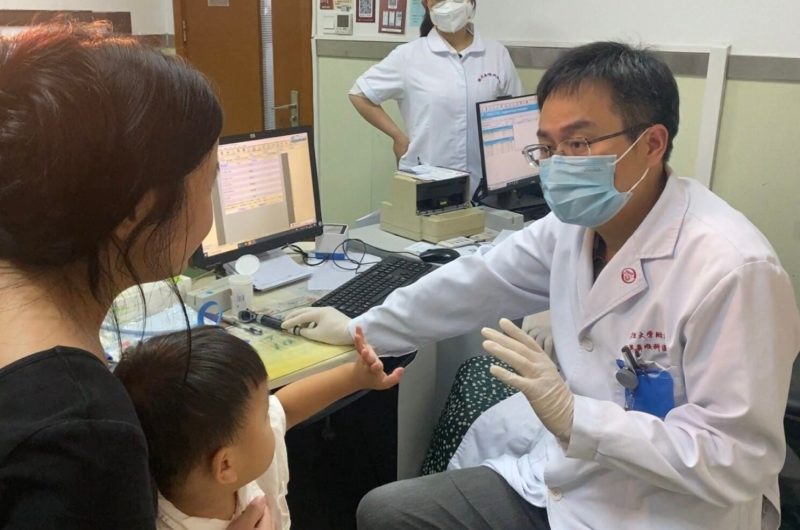Yilai Shu communicates with a young patient at the Eye & ENT Hospital of Fudan University.
Credit: Eye & ENT Hospital of Fudan University
Health
Clear as a bell
New successful, expanded trial of groundbreaking therapy for genetic deafness suggests it may be available relatively soon
A toddler in a bright yellow shirt stands unsteadily, grasping the arm of a chair with one hand while playing with a toy on the seat with the other. His father calls from behind, but the child doesn’t react.
Six weeks later, the same child stands holding onto a table. When his grandfather calls, he spins, nearly toppling over, saved by the older man who reaches over to steady him. The dramatic change, highlighted in two video clips, documents the effectiveness of a new gene therapy for a type of inherited deafness, researchers say.
The advance was first reported in January after a trial of six children deaf since birth. The children received treatment in one ear, with five of the six gaining the ability to hear. Scientists reported Wednesday they’d expanded the trial to five more children, this time delivering treatment in both ears. All five, ranging in age from 1 to 11 years, were able to hear in both ears, researchers reported in the journal Nature Medicine.
The team reported only minor side effects such as fever and higher white blood cell counts and cholesterol. While those side effects were transitory, the children became responsive to family members’ voices and some spoke their first words in what researchers hope is a permanent fix. Two children danced to music — which requires complex sound processing — and all were able to localize sound and recognize speech in noisy environments.
“I think this gene therapy is a game-changer,” said Zheng-Yi Chen, associate professor of otolaryngology, head and neck surgery at Harvard Medical School and associate scientist at the Massachusetts Eye and Ear Infirmary’s Eaton-Peabody Laboratories. “I have no doubt it will become the standard therapy down the road.”
That journey, said Chen, one of the study’s senior authors, may not take long. Further studies are needed to refine the therapy, he said, but it could be ready in as soon as three to five years.
The work was led by researchers at Mass Eye and Ear and at the Eye and ENT Hospital of Fudan University in Shanghai, where a team led by Yilai Shu, a former postdoctoral fellow in Chen’s lab, conducted the trial beginning in July 2023. The report provides a snapshot of changes after 13 and 26 weeks, though researchers are continuing to follow the subjects.
Yilai Shu’s research team.
Credit: Eye & ENT Hospital of Fudan University
“Children’s lives will be profoundly impacted by the therapy,” Shu said. “It provides a paradigm shift in the treatment of hearing impairment.”
More than 5 percent of the global population — 430 million people — have some kind of deafness, a figure that includes 34 million children, according to statistics cited in the paper. About 26 million have been deaf since birth, with about 60 percent of those due to genetic factors.
The children in both trials suffered from DFNB9, a type of deafness caused by a mutation in the OTOF gene. The mutated gene causes the body to produce a dysfunctional otoferlin protein. Otoferlin is produced by cells in a snail-shaped part of the inner ear called the cochlea, where sound waves are translated into electric signals.
Those signals are normally transmitted to the nerves and then travel to the brain for interpretation. Otoferlin is important in the handoff of the signal from the cochlea to the nerves. Without it, the signal generated in the ear never makes it to the brain.
Chen said in January that DFNB9 is an attractive target for the therapy because the structures of the ear are intact and the mutated protein can be traced to a single gene that, if repaired, would restore communication between the ear and brain.
A complication remained, however. The gene that encodes otoferlin is large enough that it doesn’t fit inside the neutered virus that researchers used to transport the corrected gene into the cochlear cells.
Researchers solved that problem by breaking the gene in two and sending it in two viral packages instead of one. Though the virus inserted the gene into the cochlear cells’ genome in two pieces, it still produced functional versions of the otoferlin protein.
In the current trial involving two ears, Chen said safety of the treatment was an important consideration. Because they used a virus to deliver the therapy, they had to be on guard for the body’s natural immune reaction. To keep that response from derailing the trial, they decided to treat both ears at once. That prevented a situation where, if the injections were given sequentially, an immune response primed by treatment in the first ear could affect the success of the second. Researchers recorded no toxicity and saw no serious adverse reactions.
“This would suggest that maybe there’s some plasticity in the brain in a patient that we could remodel somehow in the future. This opened up a new field for us to explore.”
Zheng-Yi Chen
Shu said he was both relieved and happy when results showed children being able to respond to sound cues and speak their first words. As gratifying, however, was the reaction of the children’s parents, who sometimes cried or expressed disbelief at the changes they saw.
This second trial also revealed an intriguing wrinkle. One participant was 11, an age considered outside the optimal range for language acquisition, thought to be from birth to around 6 or 7, Chen said. After hearing was restored, however, the 11-year-old did begin to use single words.
“This would suggest that maybe there’s some plasticity in the brain in a patient that we could remodel somehow in the future,” Chen said. “This opened up a new field for us to explore.”
While hearing impairment stems from an array of causes, Chen said there are 150 genes known to play a role in genetic deafness. The vast majority of those could be treated using a similar regimen, he said. With the success of these trials, he added, it may begin to make sense for children who show difficulty hearing to undergo genetic testing at an early age.
“For us it’s a watershed event,” Chen said. “Personally, I have no doubt we’re going to have a new therapy down the road.”
Get the best of the Gazette delivered to your inbox
By subscribing to this newsletter you’re agreeing to our privacy policy





